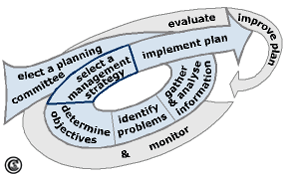Select a management strategy
Selection of a watershed management strategy within the Watershed Management planning process;
Image Credit: Anette Stumptner 2007 after data from Heathcote 1998
The next planning step is to select a reasoned watershed management strategy in order to achieve the determined objectives. This is a crucial step which includes several tasks for the planning committee:
- determination of constraints (e.g., budget), decision criteria (e.g., probable life of structures) and criteria weights;
- determination of a method to compare management alternatives (screening method); these can be very simple ones such as graphical matrixes or more complex ones such as simulation models which show the impacts of each alternative)
- developing a long list of possible management options on the basis of the watershed inventory (e.g. contour ploughing or terraces discussed in soil and water conservation; but this is only a selection!); compilation of a list of possible management strategies which are composed of the individual options and their combinations.
- elimination of options by criteria (e.g., if too expensive).
- testing of the remaining feasible options by application of the determined screening methods and decision criteria [13];
- choosing the best management strategy;
- putting together an action plan, a list of measures for implementing the selected alternatives; usually these will fall into four types: information/education, technical assistance, funding and regulatory [14].
The measures that are actually implemented locally are called implementation tools. The watershed management strategy selected for the Gina River catchment is presented on the following page.



